
Mammillaria vetula (syn. subsp. gracilis) on 7-30-13, 165-43.
The Genus Mammillaria
mam-mil-AR-ee-uh
The genus, Mammillaria Haw., was named and described by Adrian Hardy Haworth in Synopsis Plantarum Succulentarum in 1812. It is one of 150 currently accepted genera in the Cactaceae family. The family, Cactaceae Juss., was named and described by Antione Laurent de Jussieu in Genera Plantarum in 1789.
As of 12-8-23 when this page was last updated, Plants of the World Online lists 139 species in the Mammillaria genus.
Some of the best, nicest, easiest to grow, and most collected cacti are Mammillaria species. For the most part, if you purchase a Mammillaria with a label you can check with Plants of the World Online to see if the name on the label is an accepted name or now a synonym of a different species. That happens a lot and it can get confusing at times. Once you have the name figured out, you can go to the LLIFLE (Encyclopedia of Living Forms) and find more information about your plant. However, you may find it under a synonym… The website is HUGE and has a lot of information and I am sure it is hard to keep up with name changes. If you bring home an unlabeled plant and want to identify it, there are several Facebook groups with pretty good members. One of the best ways is to get on the CactiGuide, sign up to the forum, and post photos (top, sides, close-ups, etc.) in the category for Cactus ID.
Most Mammillaria species are “variable”, which is a word I am beginning to dislike A LOT. Descriptions may not “exactly” fit your plant. Spine count and size are variable within the species which led to a multitude of species, forms, subspecies, and varieties being named for the same species. Small plants (juveniles) grow and change somewhat over time as well. Spines get longer, they grow wool and hair in the axils (or it gets longer). You may have a wooly species with short hair then bring home other plants of the same species that have long hair and just a small amount of wool or even none at all. Some species may have no central spines but a variant of it may have 1-3… In the wild, a group of plants may have the same features, but in another area, the same species may look completely different. Most cultivated plants (grown in mass quantity and sold at Walmart, Lowe’s, etc. are very small and have to “grow into” what they will eventually look like. If you are fortunate enough to find plants with labels you are already headed in the right direction, however, the industry trend to sell plants merely labeled “CACTUS” is a frustrating start.
I also use several other websites for plant names and cactus and author research including Llifle (Encyclopedia of Living Forms), CactiGuide by Daiv Freeman, Dave’s Garden, and a few others as needed. For author name research I use The International Plant Name Index through Plants of the World Online and Tropicos (a division of The Missouri Botanical Garden).
There is the ongoing dilemma of the industry mislabeling plants and sites like Llifle and the CactiGuide are very useful tools to make a positive ID. If you are still confused, like I mentioned, post photos on a Facebook group or get on the CactiGuide forum.
The following Mammillaria pages are about my journey with the Mammillaria companions I have been blessed to know. I have lost a few along the way, but there will be more to come.
The links below will take you directly to information about the genus Mammillaria.
If you have any comments, questions, or suggestions, please don’t hesitate to leave a comment below. Please click on “like” below if you have visited this page. It helps us bloggers stay motivated. 🙂
FOR FURTHER INFORMATION:
PLANTS OF THE WORLD ONLINE
2013 VERSION OF THE PLANT LIST
LLIFLE (ENCYCLOPEDIA OF LIVING FORMS)
CACTUIGUIDE
WIKIPEDIA
WORLD OF SUCCULENTS
GARDENING KNOW HOW
DAVE’S GARDEN
MAMMILLARIAS.NET
CACTUS ART

Mammillaria compressa (var. bernalensis) at 2″ tall on 8-17-21, #826-36.
I brought this group of three Mammillaria compressa (syn. var. bernalensis) (Mother of Hundreds) home from Wal-Mart on December 15 in 2020. The label on the pot just said “CACTUS” which was already quite obvious. Figuring out what species it was led me on a VERY wild goose chase.
<<<<+>>>>

Mammillaria decipiens (syn. var. camptotricha) (Bird’s Nest Pincushion) on 7-30-18, #488-14.
The Mammillaria decipiens (syn. var. camptotricha) (Bird’s Nest Cactus) has been a great cactus. I brought it home from Wal-Mart on March 19 in 2018 and it has grown and flowered very well. When I brought the plants inside on October 28 in 2021 there were 12 offsets in the pot…
<<<<+>>>>
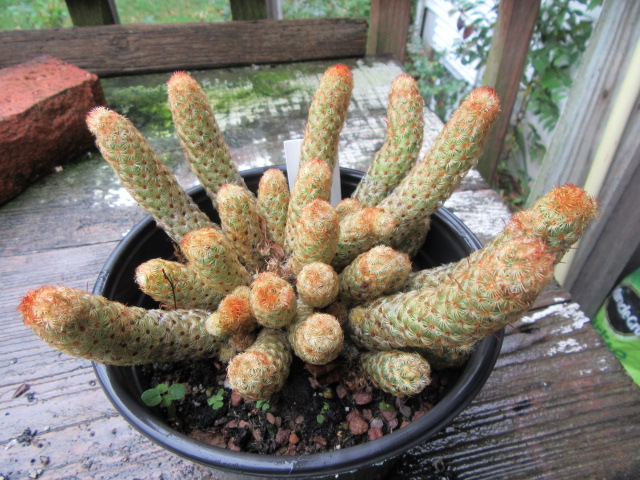
Mammillaria elongata (Ladyfinger Cactus) on 10-28-21, #853-13.
When I brought this Mammillaria elongata (Ladyfinger Cactus) home from Wal-Mart on March 19 in 2018 there was a long stem with 11 offsets. When the above photo was taken on October 28 in 2021 there were at least 39… The main stem broke in half over the winter then died over the summer…
<<<<+>>>>

Mammillaria hahniana (Old Lady Cactus) at 3 5/8″ tall x 3 3/8″ wide on 10-15-20, #747-67.
The Mammillaria hahniana (Old Lady Cactus) is quite a variable species. I was fortunate to find one with this much wool when I brought it home from Wal-Mart on February 1 in 2016. I brought two very small plants home in 2020 whose labels just said “CACTUS” that were different than the other plants in my collection. They both turned out to be variations of Mammillaria hahniana… Unfortunately, they both died over the summer… I didn’t use the photo from 2021 because we had rain and its wool was wet. She didn’t want that photo spread around. 🙂
<<<<+>>>>

Mammillaria karwinskiana (syn. subsp. nejapensis) (Silver Arrows) flowers on 11-18-19, #653-2.
The Mammillaria karwinskiana (syn. subsp. nejapensis) (Silver Arrows) has turned out to be a great plant with amazing flowers. It may have a few flowers over the summer, but it really puts on a show after the plants are brought inside for the winter. I brought this plant home from Lowe’s on September 21 in 2018. The label said it was a Mammillaria nejapensis, which is considered a synonym of Mammillaria karwinskiana.
<<<<+>>>>

Mammillaria muehlenpfordtii (Golden Pincushion) on 6-24-21, #803-18.
Mammillaria muehlenpfordtii (Syn. M. celsiana) (Golden Pincushion) is a neat cactus with kind of a bluish-green stem with long central spines an A LOT of radial spines. It produces a lot of buds but I have yet to see its flowers open. I brought this cactus home from Lowe’s on September 21 in 2018 and have thoroughly enjoyed it. The label said it was a Mammillaria celsiana which is one of 20 synonyms of Mammillaria muehlenpfordtii.
<<<<+>>>>
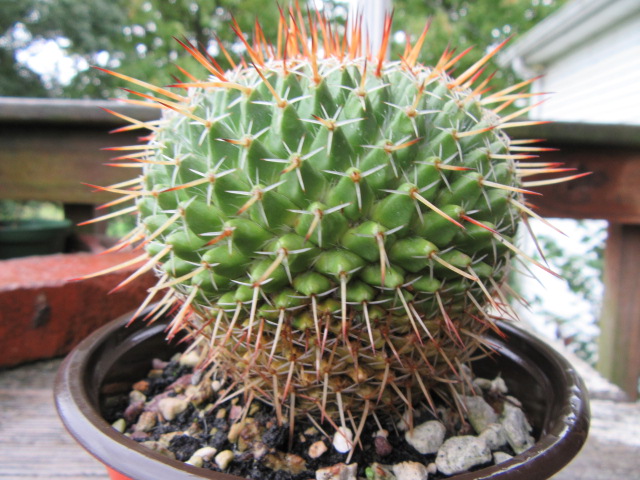
Mammillaria mystax at 3 1/8″ tall x 3 1/4″ wide on 10-28-21, #853-19.
The Mammillaria mystax has been a great cactus. It may seem like like an ordinary cactus, but it has a lot of character and 28 synonyms… I brought this plant home from Lowe’s on September 21 in 2018.
<<<<+>>>>

Mammillaria nivosa (Wooly Nipple Cactus) at 1 3/4″ tall x 2″ wide after I brought it home on 12-2-20, #767-13.
I brought this neat little Mammillaria nivosa (Wooly Nipple Cactus) home from Wal-Mart on December 2 in 2020. Unfortunately, it died over the summer in 2021.
<<<<+>>>>

Mammillaria plumosa (Feather Cactus) on 11-6-20, #755-3.
The Mammillaria plumosa (Feather Cactus) has been a very interestng and unique addition to my collection. I ordered this one from a seller on Ebay and it arrived safe and sound on September 22 in 2018 wrapped in toilet paper. It has done quite well and more than doubled in size.
<<<<+>>>>
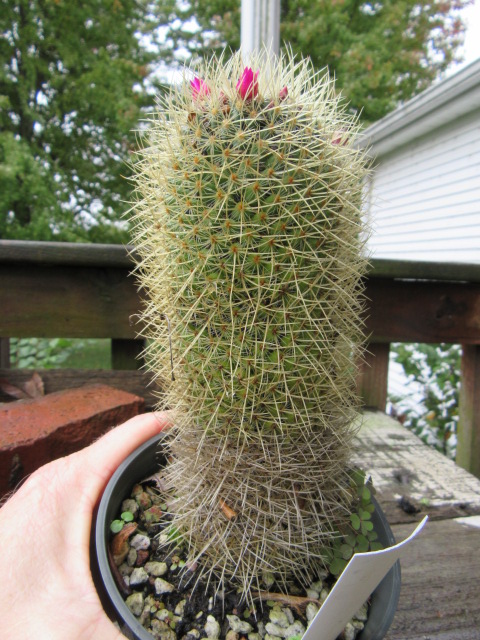
Mammillaria pringlei (Lemon Ball Cactus) at 6 1/2′ tall x 2 5/8″ wide on 10-28-21, #853-21.
The Mammillaria pringlei (Lemon Ball Cactus)… Well, it really doesn’t need an introduction. It has been an impressive plant and has grown from 4 1/2″ tall when I brought it home from Lowe’s on April 24 in 2017 to 6 1/2″ tall. I always measure the cactus and some of the succulents when I bring hem inside for the winter. It blooms sporidacclly throughout the year but mainly after I bring it inside for the winter. It is a bit of a leaner and needs re-potted on occasion to straighten it up…
<<<<+>>>>
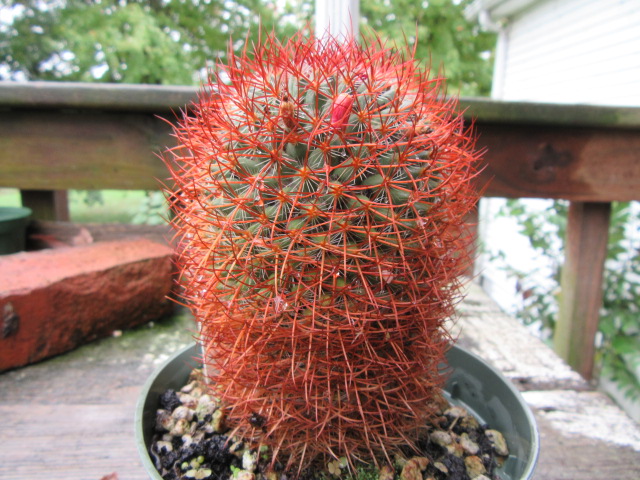
Mammillaria rhodantha (Rainbow Pincushion) at 4 1/8″ tall x 2 3/4″ wide on 10-28-21, #853-23.
The Mammillaria rhodantha (Rainbow Pincushion) is quite a showstopper with it red spines. Everyone loves this cactus! Mammillaria rhodantha is quite a variable species and had 132 synonyms the last time I checked. I was quite fortunate to have found one with red spines when I brought it home from Wal-Mart on February 1 in 2016. There are many species inthe Mammilllaria rhodantha complex and Mammillaria pringlei is one of them.
<<<<+>>>>

Mammillaria senilis on 8-17-21, #826-37.
Ummm… I bought this Mammillaria senilis from a seller on Ebay and it arrived on November 30 in 2020 when it was 1″ tall x 1 1/2″ wide. Normally, I ignore the spines when I measure the cactus but that was very difficult with this one… I didn’t even measure in 2021 and I am not 100% sure it is even alive. Well, it it were dead it should have shriveled up. When I took the above photo on September 17 in 2021, I noticed it was just sitting on top of the soil AGAIN. I am not why it keeps getting uprooted but putting it back in the soil can be tricky. It has hooked spines that stick to almost everything. I did put it back in the soil in the center of the pot a few days after the above photo was taken. You may be surprised, but there are several species of Mammillaria with hooked spines…
<<<<+>>>>

Mammillaria spinosissima ‘Un Pico’ (Bald-Headed Irishman) at 3″ tall x 1 7/8″ wide on 8-18-21, #827-22.
I found this plant at Wagler’s (a local greenhouse) on April 3 in 2021. It’s label said it is a Mammillaria spinossissima ‘Un Pico’ but photo on the label shows a plant with long spines. I did some research and found out ‘Un Pico’ is a stable genetic mutation of very spiny species that only produces one spine per areola and some areoleas may not have spines. This plant has 1-3 short spines per areola and a few with none. Apparently, Mammillaria spinosissima is a highly variable species and has 107 synonyms. One of its common names is Bald-Headed Irishman… This plant doubled in height from April 4 at 1 1/2″ tall to 3″ tall on August 18. That’s only 4 months. Information says this species can fill a pot with offsets in just a few years. Time will tell…
<<<<+>>>>
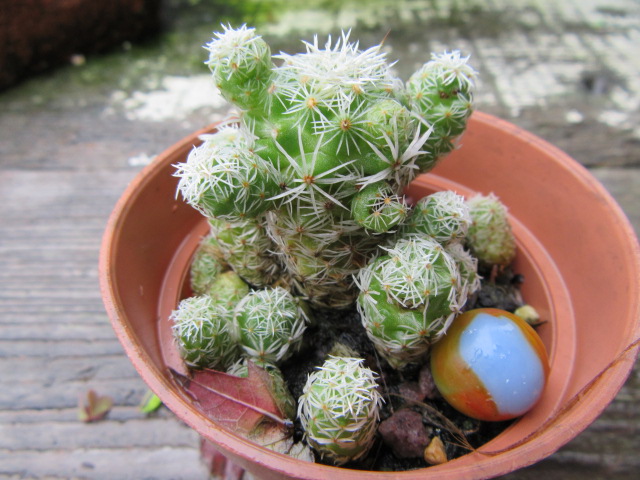
Mammillaria vetula (syn. subsp. gracilis) (Thimble Cactus) at 1 7/8″ tall on 10-28-21, #853-25.
I needed a replacement for the Mammillaria vetula (syn. subsp. gracilis)(Thimble Cactus) I gave up in 2014 and found a very small one at Wagler’s in September 2018. I didn’t recognize it at first because it was a single stem plant with a few offsets sticking outof it. I was used to seeing them sold as a cluster of offsets. For a while all the offsets this plant produced fell off but a few managed to hang on since 2020. It definitely needs a larger pot… These cactus are normally sold in garden centers as Mammillaria gracilis fragilis or something along that line. Even though there are differences between the species and subspecies, the subspecies is now considered a synonym… The photo at the top of the page is the first Thimble Cactus I brought home in 2013…
<<<<+>>>>
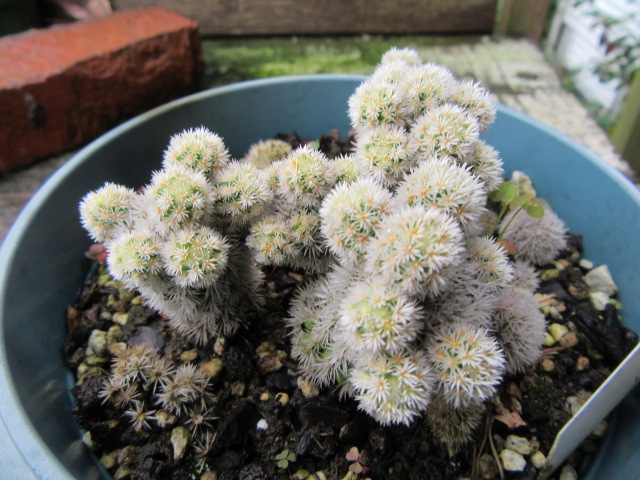
Mammillaria vetula (syn. subsp. gracilis) ‘Arizona Snowcap’ at 2 1/4″ tall on 10-28-21, #853-24.
Well, the Mammillaria vetula (syn. subsp. gracilis) ‘Arizona Snowcap’ has had a few issues but Ithink it is over the hump now. I brought it home from Lowe’s on July 7 in 2018 while looking for a replacement for the first Thimble Cactus. Actually, it was just an excuse to sneak tothe garden center. Anyway, I found one and also this plant labeled Mammillaria gracilis fragilis monstrose… I wound up bringing the I decided to bring home the latter because it was so white and I never had one before (or even seen one). Upon research, I found it was a monstrose mutation of “the other one” produced in a nursery and possibly a hybrid called ‘Arizona Snowcap’. Over the winter I took a couple of photos and a few of the offsets in the pot were nearly solid white and looked like little snowballs. Those plants died… In fact, half of the offsets died. I re-potted what was left and the rest have done pretty well.
That is it for the Mammillaria for now. I am sure I will be adding more to my collection…